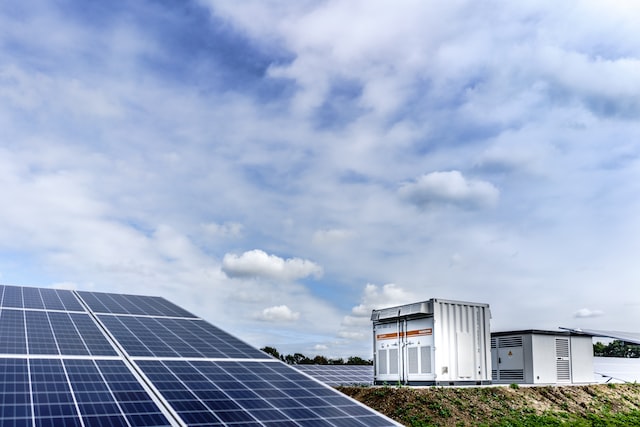November 10, 2023
Scaling up green hydrogen for inclusive growth, better jobs, and lower emissions
Clean hydrogen, including green hydrogen, is a building block for the energy transition. It can potentially eliminate the world’s reliance on fossil fuels, especially in hard-to-abate sectors, and contribute to achieving net zero emissions. We can produce green hydrogen by harnessing renewable energy sources like wind and solar power.
As low-income countries and vulnerable populations experience the worst of climate change, investing in resources for a world free of poverty on a livable planet is more pivotal than ever. Green hydrogen can play a key role in creating skilled jobs in local communities while contributing to cleaning the air and spurring the energy transition through public and private investments.
But first, countries need to industrialize their clean hydrogen production to address the growing demand. Scaling up can help reduce the cost of green hydrogen and make it more competitive compared to other most commonly used sources, such as hydrogen produced from fossil fuels. With the drop in renewable energy prices and technological advancements, this is an opportune moment to deploy this energy carrier on an industrial scale. Infrastructure investments and policy support are necessary to achieve this goal to encourage private sector engagement, especially in developing countries.
Developing countries with good renewable energy resources can produce green hydrogen locally, generating economic opportunities and reducing exposure to oil price volatility and supply disruptions. Regions such as Latin America and the Caribbean have the potential to scale up the green hydrogen industry due to their vast renewable energy sources. This region already has a solid base to build on to become a global leader in clean energy, with countries such as Brazil, Uruguay and Paraguay having more than 85% renewable power matrix.
Chile: Innovation from Pilot to Industrial Scale
The World Bank approved this year a $150 million project worth to promote clean hydrogen development in Chile. This project is the first-ever of its kind approved by the World Bank and will support the country’s goal to achieve carbon neutrality by 2050. This project includes innovative financing mechanisms that encourage green hydrogen use, stimulate economic activities, create jobs, and enhance local capacity building.
The project will create a green hydrogen facility to help lower the cost of green hydrogen subprojects and scale up the industry. Blended finance and risk mitigation instruments will be provided to partially fund renewable green hydrogen production projects, including electrolysis systems, compression, and storage elements and help manage payment and technical performance risks to mobilize private sector capital. The project will help alleviate the financial and early-stage constraints that this industry currently faces.
The project will kick-start a new industry that will create local green jobs and value chains, help decarbonize hard-to-abate sectors, and increase the competitiveness of local industries such as mining, freight and heavy transport, and agriculture. It will also create new export opportunities in green hydrogen derivates, such as green ammonia and e-fuels, to support a greener and resilient economy.
This facility, under the Chilean Economic Development Corporation’s (CORFO) leadership, has convened resources from other climate finance institutions. The facility has already leveraged $1 billion in concessional financing, with commitments from multilateral and international organizations, thereby increasing the project’s impact on private capital mobilization, resulting in a multiplier effect that will further benefit the communities in Chile.
Chile’s recent project opens an opportunity for other developing countries to follow in its footsteps and leverage their solar and wind resources to decarbonize, reduce inequality, and promote green and inclusive growth. Like Chile, other countries in the region are emerging in the development of green industries, which will help them achieve their sustainable development goals.
Several countries in the region, including Brazil, Colombia, Ecuador, Costa Rica, El Salvador, Peru, and Uruguay, have already developed strategies or published blueprints to accelerate green hydrogen usage and decarbonize various sectors, such as heavy and marine transportation, the food industry, and fertilizer production.
The World Bank also supports Brazil, Costa Rica, Colombia, and other countries. In over 20 countries, the World Bank is helping governments identify near and long-term investment opportunities, tackling challenges related to deploying green hydrogen technologies and realizing economic opportunities.
Recently, the Brazilian federal government gave the green light for the first Green Hydrogen Hub shared infrastructure project at the Industrial and Port Complex of Pecém, in the state of Ceará, in the country’s northeastern region. With a total cost of $135 million, this will constitute the World Bank’s first green hydrogen shared infrastructure project. The project comprises the expansion and preparation of a pier for ammonia movement, the expansion and preparation of a pier for other related hydrogen products, and the preparation of an area for the utilities corridor.
Scaling up green hydrogen is essential for transitioning to a low-carbon economy. Accelerating this industry offers the potential for a sustainable energy system that can power the world without emitting harmful greenhouse gases at a time that creates jobs and reduces poverty. Hastening investments in infrastructure, technology development, and policy support will be critical for the deployment of this industry and for achieving a sustainable and just transition.
Source: World Bank Blogs
Legal Notice: The information in this article is intended for information purposes only. It is not intended for professional information purposes specific to a person or an institution. Every institution has different requirements because of its own circumstances even though they bear a resemblance to each other. Consequently, it is your interest to consult on an expert before taking a decision based on information stated in this article and putting into practice. Neither Karen Audit nor related person or institutions are not responsible for any damages or losses that might occur in consequence of the use of the information in this article by private or formal, real or legal person and institutions.






